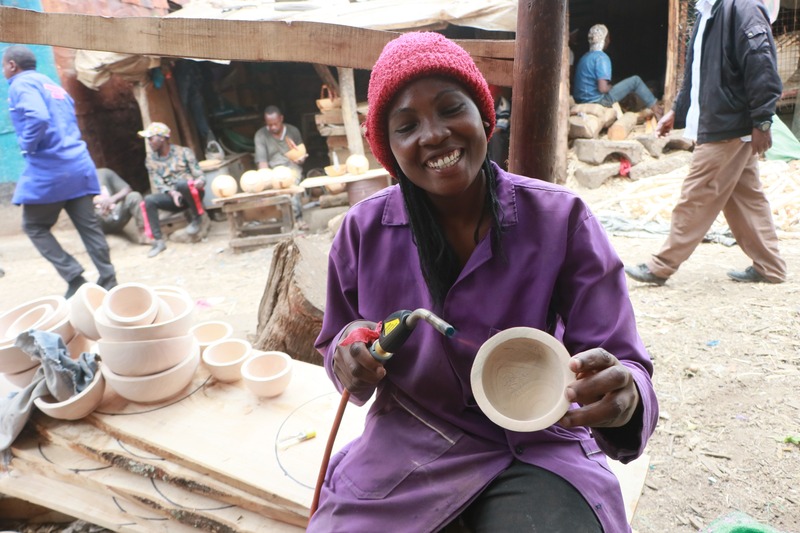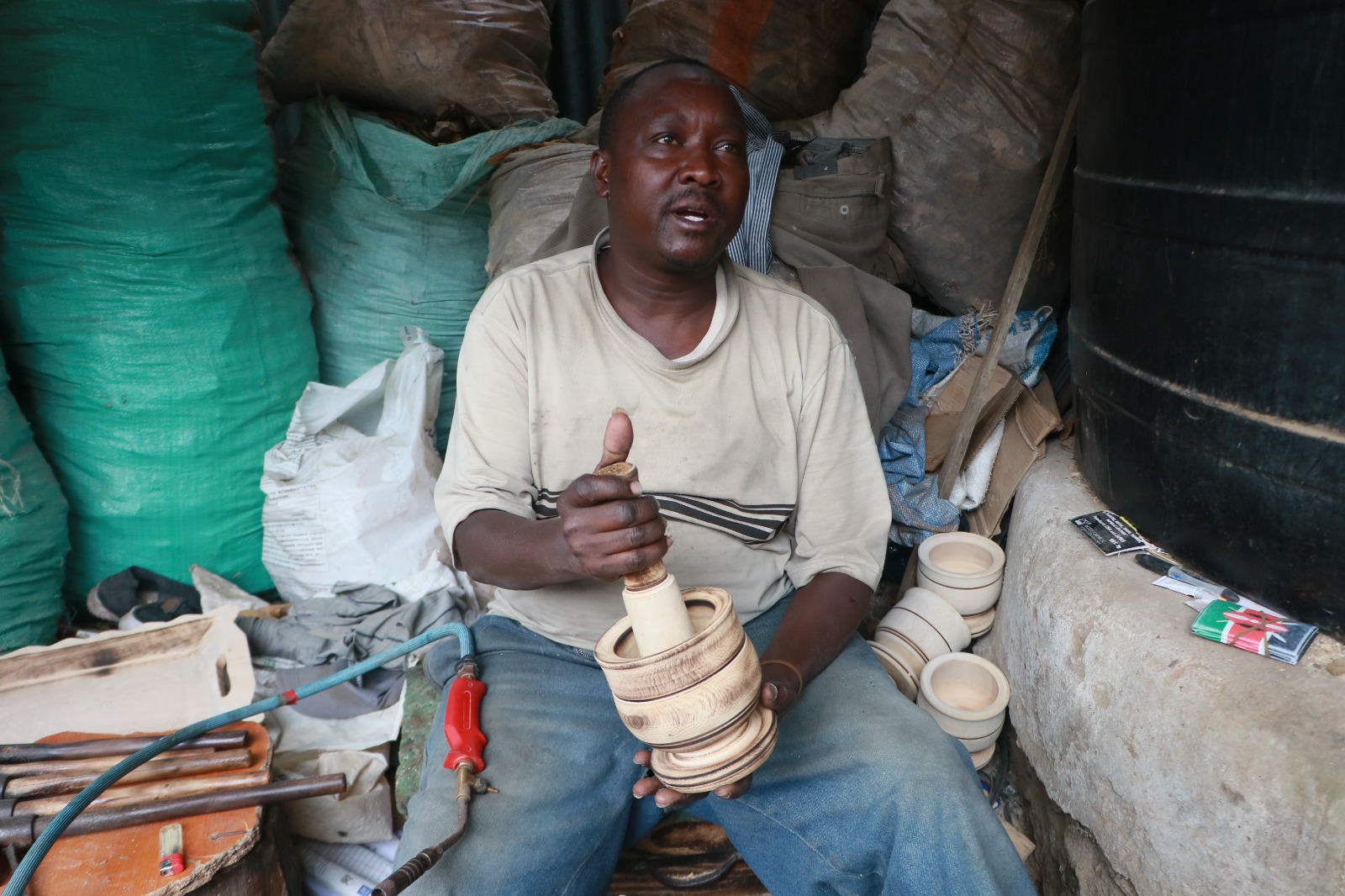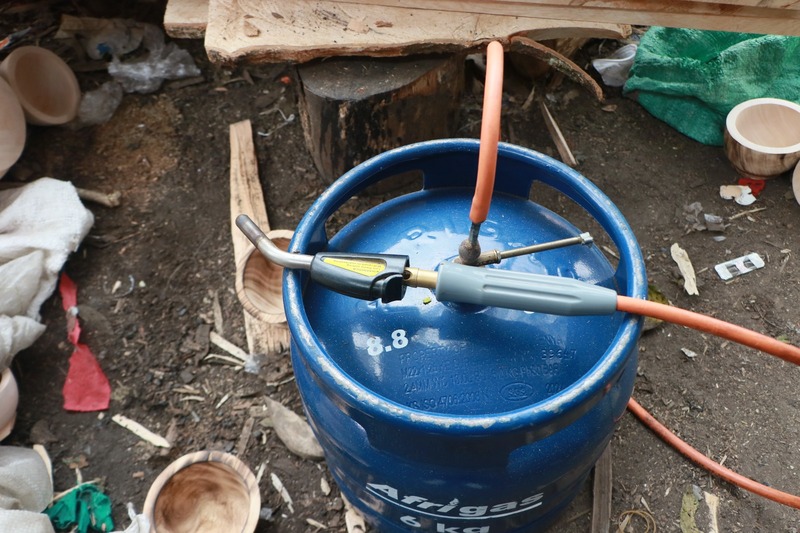From kitchen to workshop: How craftsmen are revolutionising sculpture polishing using gas cylinders

The soft, controllable heat allows Peter to reveal subtle textures and nuances in each piece, enhancing the depth and richness of the colours.
Peter Mutoko breathes life into his sculptures with every touch, carefully adjusting the flames from a repurposed home gas cylinder, now used alongside a modified torching gun.
The familiar hum of the gas cylinder is a reminder of how unconventional tools, in the hands of a skilled artisan, can become essential. As Peter polishes his finished sculptures, ready for the market, his hands move with precision, gliding smoothly across the surfaces to ensure a flawless, consistent finish.
More To Read
- Creativity in crisis: Kitui village artisans fight to save Nairobi’s craft heritage after market fire
- Kenya to introduce mandatory digital ID for online sellers in new e-commerce crackdown
- Dark SME Day: Small-scale businesses face hefty losses due to protests
- Traders count millions in losses after protest looting and arson across Kenya
- Scars of protest: Sunbeam traders still await justice following 2024 fire tragedy during anti-tax demos
- Why investing in a quality gas burner matters and how to spot a fake
While many associate gas cylinders with cooking, this technique, born out of necessity during the Covid-19 pandemic, has transformed their approach to polishing. Discovered by a fellow artisan, the use of a home gas burner has revolutionised their work.
The soft, controllable heat allows Peter to reveal subtle textures and nuances in each piece, enhancing the depth and richness of the colours.
“For years, many clients complained about the smell of paint. We didn’t have an alternative because industrial soldering torches were too expensive. But after Covid, we noticed one of our artisans using a gas cylinder. Upon asking, we realised it was a viable option, as long as precautions were taken,” Peter explains.
He has adapted the equipment, repurposing pipes to make the setup both convenient and safe for him and others.
“This setup is very safe, and I can easily regulate it. We work in open spaces and limit our working time to avoid inhaling too much gas, which can be unhealthy. So far, it has greatly improved the aesthetics of our business. Clients love the finished products, and they no longer have to worry about the smell of paint.”
 Peter Mut0ko, an artisan at Nairobi Handicraft Cooperative Society in Kamukunji Sub-county, uses gas flames to decorate and shape different products to look more attractive on September 25, 2024. (Photo: Justine Ondieki)
Peter Mut0ko, an artisan at Nairobi Handicraft Cooperative Society in Kamukunji Sub-county, uses gas flames to decorate and shape different products to look more attractive on September 25, 2024. (Photo: Justine Ondieki)
Peter notes that a modern industrial torch can cost up to Sh20,000, a price beyond the reach of many artisans, while a gas cylinder costs only Sh1,100 and lasts him about a month, using it two hours a day.
“Sometimes, people who don’t have a custom torch come to me for help. The equipment also emits a smell when the gas isn’t sealed properly, so we can easily manage any potential issues.”
Peter’s business has enabled him to support his family and put his children through school. His only regret is not discovering this technique sooner, though he has been using it for nearly four years now.
Nearby, another artisan, 27-year-old Scholastica Atea, has found a stable income through her skill in torching sculptures, a highly regarded trade in Nairobi’s vibrant handicraft scene.
“I started by working for someone else, but after seeing other artisans using gas cylinders and modified soldering guns, I became intrigued. I decided to learn the technique myself, and I’ve never looked back,” she says.
Her passion for the craft shines through as she explains how mastering the skill has transformed her life.
Scholastica emphasises the need for precision and consistency. “If you’re not careful, it’s easy to burn the sculptures, which can be very discouraging.”
She recalls the challenges she faced when starting, particularly the risk of burning herself.
“You have to rotate the tool in your hand to ensure the heat is distributed evenly across the surface. It’s daunting at first, especially when the wood gets extremely hot,” she adds.
Despite these challenges, Scholastica has developed a deep appreciation for the craft. “Once you learn to control the heat and the tools, it becomes a beautiful experience.”
She finds joy in transforming raw materials into stunning works of art, each with its unique character.
 A 6kg gas cylinder used by artisans. (Photo: Justine Ondieki)
A 6kg gas cylinder used by artisans. (Photo: Justine Ondieki)
Through dedication and perseverance, Scholastica has built a solid reputation within the artisan community. Her work not only provides her with a reliable income but also allows her to express her creativity and connect with customers who appreciate handcrafted art.
“I encourage women to embrace this kind of technical work because there are plenty of opportunities. Every day, I earn between Sh600 and Sh1,000, which is enough to support myself and my family.”
Scholastica takes on piecework, moving from one artisan to another, assisting with polishing and sanding their finished products.
While some may worry about the risks, traders in Nairobi’s handicraft scene have embraced this method as an affordable alternative to industrial torch guns.
David Kilonzo, the chairperson of the Nairobi Handicraft Cooperative Society, stresses the importance of safety, ensuring gas cylinders are properly sealed and handled with care.
Since adopting this method, they haven’t experienced any accidents. The polished products created using this technique are not only visually striking but also highly favoured by customers.
Top Stories Today
- Three former Somali presidents condemn government over deadly land evictions
- Islamic banking in Kenya gets boost with launch of new finance association
- High Court lifts rice import ban, cuts volume by half
- Ruto refers Wildlife Conservation Bill back to Parliament for reconsideration
- KeNHA announces two-week closure of section of Mombasa-Nairobi Highway
- Regional security summit in Nairobi targets rising cross-border terror threats












































